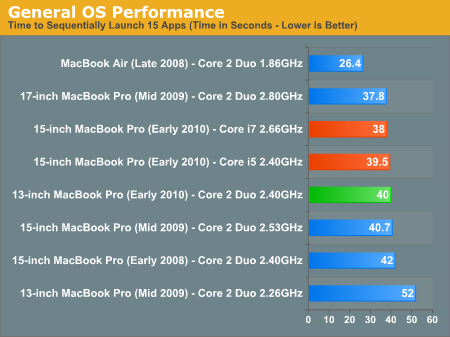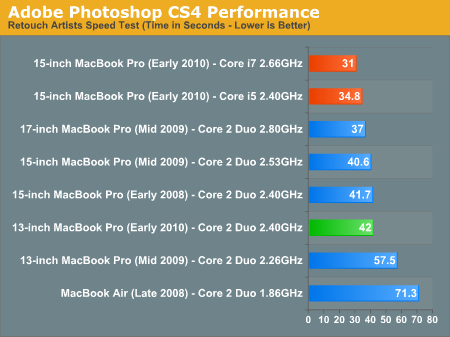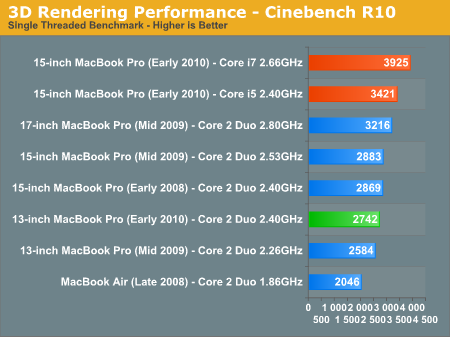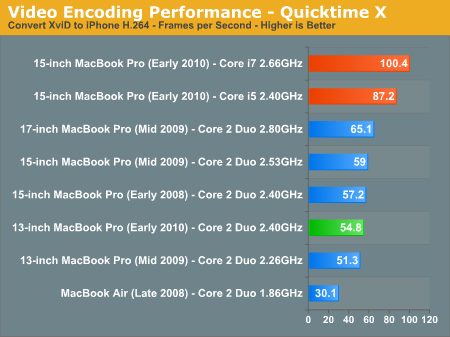Apple's 13-inch MacBook Pro (Early 2010) Reviewed: Shaking the CPU/GPU Balance
by Anand Lal Shimpi on June 9, 2010 12:15 AM EST- Posted in
- Mac
- Apple
- Intel
- MacBook Pro
- NVIDIA
General Performance: A Mild Improvement
We know what the GPU upgrade is good for, but what about the mild CPU bump in the 2010 13-inch MacBook Pro?
General OS usage is a difficult thing to quantify, but one measure of performance has always been the number of bounces an icon in the dock makes before an application loads. I decided to take it to the next level and write a quick script to launch 15 applications in a row, timing how long the entire process takes.
I launched, in order: Mail, Safari, Activity Monitor, iTunes, iCal, DVD Player, iPhoto, Photo Booth, Quicktime Player, Disk Utility, Preview, iMovie, Front Row, Garage Band and Aperture.
The entire process stresses both the disk and CPU, which is why we see a huge improvement when going to an SSD as well as differences between CPU speeds.

Application launch performance improves tremendously compared to last year's model thanks to the now standard 4GB of memory. The 2GB last year's model came with just wasn't enough. Now if you upgraded your previous gen 13-inch MBP then you'll hardly notice a performance improvement.
Also pay attention to just how well the Late 2008 MacBook Air does in this test. That's thanks to its SSD. Add an SSD to any of these notebooks and you'll see a similarly awesome increase in performance.
Adobe Photoshop CS4 Performance
The Retouch Artists Speed Test we use for our CPU testing under Windows also works under OS X. We're running the exact same benchmark here, basically performing a bunch of image manipulations and filters and timing the entire process.

Start doing real work with the 13-inch MacBook Pro and you'll note that it's significantly slower than the new 15-inch models. The Core i5 just rocks. Compared to last year's model the new MBP is much faster, but again that's due to the 4GB vs. 2GB of DDR3 that comes standard with the machine. An upgraded 2009 13-inch MBP would be basically the same speed.
Aperture 2 RAW Import
For my Aperture test I simply timed how long it took to import 203 12MP RAW images into the library.

Photographers and digital media creation professionals will want to opt for the 15-inch MacBook Pro, the faster CPU is definitely worth it.
Cinebench R10

In situations where we're not memory bound, the improvement over the previous generation 13-inch model is small. The performance improvement here is 6%. I'd say in most apps you'd see a 2 - 4% improvement over the 2.26GHz 13-inch from last year.

Quicktime H.264 Video Encoding
Our final benchmark is more consumer focused. Here I'm taking an XviD and converting it to an iPhone-supported H.264 format.

Encoding performance is improved over last year's 2GB/2.26GHz model, but no where near as much as the Core i5/i7 managed with the 15-inch model. If you're doing anything CPU intensive, the new 13-inch MacBook Pro isn't an upgrade.










93 Comments
View All Comments
oldbriones - Wednesday, June 9, 2010 - link
Glaringly missing in display evaluation is any mention of the viewing angle. Anandtech probably knows that the supposedly "Pro" models have cheap TN LCD type thus resulting in crappy viewing angles. I expect Anandtech to educate its readers about availability of better screens so that manufacturers will respond to the market demand.Zok - Wednesday, June 9, 2010 - link
Good point, but when was the last time you've seen a laptop not sporting a TN LCD?Penti - Wednesday, June 9, 2010 - link
Only tablet-PCs don't and they are only on IPS-based tech since recently and in smaller sizes, as far as I'm aware of there is no 15" low power laptop panel in existence or being manufactured. They can't use something that aren't manufactured, and a display like that isn't in the catalogs of the Korean and Taiwanese panel manufacturers and are frankly out of most of theirs capability. Many of them simply don't make any IPS screens at all. Haven't seen PVA panels in those sizes and power envelope or anywhere near.IPS screens in devices like iPad was unheard of before LG put one together for Apple and hard to imagine. As netbooks and low cost devices use TN panels and e-readers use reflective technology.
Every photoguy knows the macbooks screens aren't worth a shit and that they need a calibrated external screen for referencing and work. So I hope it doesn't come as a surprise to anybody. The MBP screens aren't worse then any others. But it's still pretty useless for a lot of things. Any way that's what the review of monitors is for. They have done more detailed reviews of laptop screens too, but they only confirm that they are horrible. I'm pretty sure also that the screens for high-end tablet PCs isn't that good when it comes to color accuracy their usage is for viewing angles. And that isn't everything.
Penti - Wednesday, June 9, 2010 - link
And when I say based on IPS (IPS-based) I mean AFFS panels. They exist for up to 14". They are actually 262k color panels, while they have good viewing angles though. LG haven't invented a unique macbook screen yet.BlendMe - Wednesday, June 9, 2010 - link
Now that Apple is shipping the iPad and iPhone 4 with IPS panels it might not take to long till they move the tech up to their MacBook line. The iMac already have it but they're not power limited like laptops.ksherman - Wednesday, June 9, 2010 - link
"Every photoguy knows the macbooks screens aren't worth a shit..."That all depends. if you shoot in AdobeRGB, yeah you would be left wanting. I shoot almost exclusively in sRGB because that's what everyone seems to want anyway. As such, near 80% coverage of the AdobeRGB spectrum works just fine.
The bigger problem is an uncalibrated display. Calibrate the display and it will get you close enough in almost ever situation.
Of course though, it always depends on your medium/use for the pictures. I shoot for newspapers. They compress the details right out of the pictures online and the half-tone process kills and color correction or detail anyway.
If I shot for a magazine, it might be a different story. I'd have a lot more money and probably wouldn't be editing and transmitting from my car more often than not.
Anyway, I love my (first gen) unibody 15" MacBook Pro, but I'm lusting after the matte high-res display and awesome battery life.
bji - Wednesday, June 9, 2010 - link
What an interesting job you must have compared to those of us who sit in front of a computer in a cubicle all day ...rpottol - Monday, June 14, 2010 - link
IPS were dropped from the Thinkpads because they could no longer be obtained in the quantities that they needed them, Apple would need them in far greater quantities (given that they were only on a few high end Thinkpads, as opposed to what apple ships).We may long after them, but for now, we are stuck with the cast offs from the TV market.
oldbriones - Thursday, June 10, 2010 - link
It was only a few years ago (granted that is a long time in tech-years) that there were beautiful high quality IPS LCD options on laptops such as IBM/Lenovo T43, T60, etc. Lately most consumers got seduced into cheap but seriously compromised (display-wise) machines, and then suffer afterward searching for that elusive head and body tilt to view the movie at. Then again, many people probably don't even know what they are missing.Stokestack - Thursday, June 10, 2010 - link
The asinine glossy screen is a much bigger defect. What is with Apple's continued ignorance on this matter? I'm using a MacBook Pro with a glossy screen right now, and it is abysmal in ALL lighting conditions. From a pitch-dark room to a sunny office.To charge extra for a matte option on the other two MBPs is bad enough, but then they don't even offer it on the computer that's most likely to leave the house and be used in a variety of lighting. There's no excuse, because the size of the computer has nothing to do with this feature.
Sad.